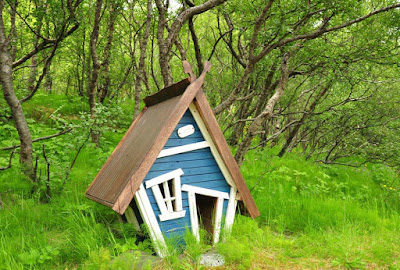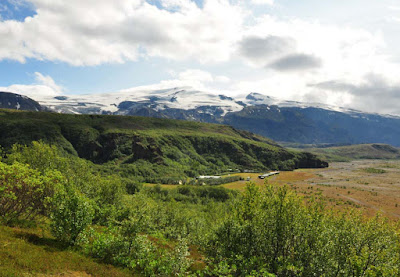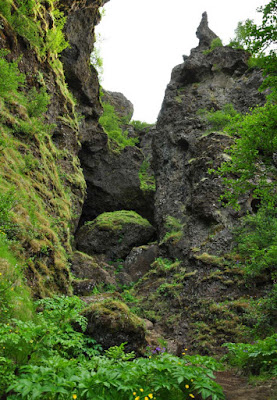 |
| Thórsmörk, Iceland, is an enchanted place, including for knee-high folk, such as those seen in front of this mini cottage. |
My friend and fellow children’s book author Caroline Hatton
visited Iceland in June 2019. She took all the photos in
this post, which she wrote to help others decide whether to visit Thórsmörk.
Thórsmörk is for hikers who love varied, dramatic
mountain scenery contrasting with fairytale woods. The name (spelled Þórsmörk in
Icelandic) means the woods of Thor (spelled Þór in Icelandic), the mighty
hammer-wielding god of thunder in Norse paganism. I guess even such an awesome
dude needs to indulge in daydreaming once in a while.*
Visitors can hike up to
viewpoints and caves, across meadows and woodland, or start multi-day backpacking
trips, for example, to the multicolor mountains of Landmannalaugar, and find
peace in the wild (if you ask me), or great parties (if you ask the students who
come in July).
 |
| Thórsmörk is a nature reserve accessible year-round. NASA image with red and white added |
I
knew better than to go to Iceland in July or August, during over tourism season,
or on a weekend to a location only two and a half hours from the Reykjavik
area, where nearly two-thirds of all Icelanders live. So I planned to go to Thórsmörk on a June Monday. My husband and I stayed
there one night to experience at least one evening and one morning. We were
almost the only ones there!
The
drive to Thórsmörk requires
leaving the excellent Ring Road (= Route 1) and turning onto road 249, which
soon becomes F249 where the pavement ends, along with the permission to drive
regular-size rental cars. No problem, since high clearance 4x4 buses go all the
way, splashing across unpredictable, glacier run-off creeks and roaring rivers.
Other options include booking a Super Jeep tour or renting a 4x4 and buying
river crossing insurance (do they mean a life vest?).
Of
the different bus companies, I chose Trex to maximize our time in Thórsmörk by arriving earlier on Monday and leaving
later on Tuesday. The bus started in Reykjavik, but we boarded it at the last
stop on the Ring Road, in the town of Hvolsvöllur where we could park a rental
car overnight.
Our
itinerary came together piece by piece.
Sunday:
-
drive the rental car from Reykjavik to Hvolsvöllur
-
stay overnight in or near Hvolsvöllur.
Monday:
-
take the bus to Thórsmörk (from the “Hvolsvöllur
N1 service station” to “Þórsmörk/Langidalur”)
-
hike to Húsadalur Hut
-
stay one night.
Tuesday:
-
hike a different way back
-
take the bus back
-
stay overnight in or near Hvolsvöllur.
The
easy hour-and-a-half drive from Reykjavik to Hvolsvöllur took us across
landscapes as different as planets, from bleak barren black lava to luscious
pastures rolling out of sight, dotted with toylike sheep, horses, and
farmhouses.
At
the Hvolsvöllur Lava Centre, we walked through the gift shop, noted the cafeteria
menu, and skipped the interactive exhibition about volcanoes, earthquakes, and
the geological formation of Iceland, because we wanted to stay outdoors. Yet, after
a picnic lunch and long stroll on hills overlooking farmland, we enjoyed a
deeply enriching visit to the Saga Centre, which houses
exhibits about Njal’s Saga, a true story set in the vicinity.
Late
in the afternoon, we drove along country road 261 to Hotel Fljótshlíð at the sheep,
goat, and horse farm where we had reserved a simple, impeccable room with
private bathroom. There, we had a fine meal in a dining room with an antique
tractor parked in the middle.
Before
bedtime, we gathered the minimum belongings we would need while away for two
days and one night at Thórsmörk in a reserved,
private, heated room with a made-up bed and towels. Our day packs
included warm layers, two lunches, one dinner, one breakfast, and snacks. It
was Summer solstice time, so the sky barely dimmed at night. Thick rubber
curtains kept the room dark enough to sleep, despite nameless pinhole constellations.
In
the morning, fog hung down to the grass tips. We filled up at the breakfast
buffet, starting with fresh fruit and skyr (Icelandic yogurt, pronounced skeer),
then sampling every delicious bread and cheese.
The
fog had lifted to the hilltops when we drove eight minutes back into Hvolsvöllur
to park the car at the Lava Centre. Carrying only our day packs, we crossed the
Ring Road to the N1 gas station, snack shop, and bus stop. Different bus
companies’ timetables hung around the outside of the building, but the Trex bus
didn’t stop near its signpost, so it was a good thing we saw it arrive.
The
driver checked our tickets, prepurchased online from the U.S., against his
tablet data, and we were off. Soon we turned into the parking lot of Seljalandsfoss,
a waterfall often photographed, from the walking path behind it, for Iceland
tourism ads. The bus made a stop, but no one was allowed to get off and back
on. Anyone wishing to visit Seljalandsfoss should do it some other time. And
even though buses to Thórsmörk stop at
Seljalandsfoss, parking a car there overnight is not allowed.
The
bus proceeded with ten passengers, leaving most of the 40 seats empty. “Seat
belts on, please!” said the driver. “The road is bumpy!” But it really wasn’t.
Seat belts must be to keep passengers from standing up to take photos, then
falling over and hurting themselves.
On
the right, where I sat glued to the window, hoping to see the Eyjafjallajökull icecap
stretching to Thórsmörk, waterfalls trickled down black rocky slopes, while bright
green grass crept up like velvety fuzz. On the left, a great braided river ran
among gravel banks, gray on gray. The bus slowed down across water channels.
A
five-minute stop near the tongue of the dirty gray Gígjökull glacier, which
flows from the Eyjafjallajökull icecap, gave me time to correct my foldout map.
I crossed out the terminal lagoon, wiped out in 2010 during the volcanic
eruption that disrupted air traffic for days.
Our
driver skipped the spur to the first of three Thórsmörk mountain-style huts, Básar (pronounced bow-sar), because no
passenger was going there. We arrived early, around 11 a.m., at the Trex
bus terminus, the second hut at Thórsmörk, Langidalur. Only
a couple of monster-sized Super Jeeps had parked there.
After
visiting the restroom (the first in an hour and a half), we proceeded up the
gentle slope to the café, where we asked for a trail map before eating our own
lunch on the terrace.
 |
| View from Valahnúkur (1502 ft ~458 m) of the Krossá glacial river, which drains the Mýrdalsjökull glacier (in the background clouds) and Eyjafjallajökull glacier (at right outside the photo). |
Of
the two trails across the mountain ridge to our hut, Húsadalur, we chose the
longer, steeper one via the Valahnúkur 1502-ft (~458-m) mountaintop 360-degree viewpoint,
less than a mile away but 1,500 feet up.
As
a hiker with excellent boots, but a cranky disposition going down slopes due to
challenges staying upright, I found the way down toward Húsadalur (the
parts without wooden stair steps) difficult, steep, with loose slippery dirt. And
it wasn’t even a rainy day.
 |
| Native Downy Birch trees (Betula pubescens), purple Wood Cranesbill (Geranium sylvaticum), and yellow Meadow Buttercups (Ranunculus acris) |
As
if to make up for the trouble, on the lower part of the slope nearing Húsadalur,
the trail took us through the promised, charming birch woods. Trees are extra
special in Iceland. After the Vikings settled the island in the 800s, they cut
down most of the existing forests to convert them to pastures for livestock and
to build homes and ships. So far a couple of generations of Icelanders have
worked on reforesting the land. Government funding to plant trees should help
with Iceland’s goal of achieving carbon neutrality by 2040.
At
Húsadalur we found a geothermal hot pond and associated small sauna, a main
building with reception desk and restaurant, a community kitchen cabin, a
shower and restroom building, an eight-private-room building with two shared
bathrooms, a row of small cottages, shared mountain hut dormitories, and grassy
grounds for glamping and camping. Cottages cause this writer delusions of
grandeur, so I assessed their potential for a personal writing retreat. The
front, big window of each cottage offered a view of the grassy tent area and
hillside beyond, and the windowless back blocked the view of the snowy mountains across the river valley. That was
backwards—not a good retreat location for me!
 |
| Our private room with shared bathroom was one of eight inside this hut. |
We
checked into our tiny, spotless room before walking upstream along the Markarfljót,
the river on our side of the mountain ridge, first on the dike, then uphill on
a trail marked by red-top wooden posts.
 |
| The Húsadalur Hut buildings, the mountain ridge between the Markarfljót (at right, not in photo) and Krossá (behind the ridge, not in photo) river valleys, and the Eyjafjallajökull icecap |
The
clouds dissipated, uncovering the gleaming Eyjafjallajökull icecap and the
massively larger Mýrdalsjökull under blue skies. We would have missed all this
beauty if we hadn’t planned to stay one night, because we would have been
hiking back to the bus stop in a valley instead of lingering on hilltops.
 |
| Do you dare climb into the Sönghellir Cave and sing? |
After
walking back, past the hut, we climbed back up the ridge to the Sönghellir Cave,
a rock cave that flatters anyone who dares to sing.
 |
| Cupboard made of repurposed crates with repurposed flatware hardware, in the community kitchen cabin. |
At
sundown, the wind dissuaded us from sitting at a picnic table, so we ate the
cold dinner we had brought inside the kitchen cabin and took advantage of the
free WiFi to find out that it would rain the next afternoon. That night we were
the only guests in the eight-room building, so we did not share the two bathrooms
down the hall—they were His and Hers.
In
the morning, we checked out after breakfast and left one day pack at the desk
before heading out. Along the trail, an information board reminded us that we
were walking on the land of ice and fire. The photogenic Eyjafjallajökull and Mýrdalsjökull
icecaps—guess why they rose where they did? Because snow piled on top of
volcanoes. The map showed evacuation routes in case the Mýrdalsjökull volcano
decided to erupt under its glacier, potentially causing cataclysmic meltwater
floods. In 2010, the Eyjafjallajökull eruption triggered the flood that flushed
out and filled with sediment the lagoon I had crossed out on my map. In
Iceland, when glacier run-off water starts heating up, it’s actually not a good
time to take a bath.
After
lunch (guess where we ate), we hiked back to the Trex bus stop at Langidalur
via the easier, shorter low-lying “Saddle” trail. Hut to hut, it took us half
the time compared to the previous day. Best of all, an Arctic Fox (Vulpes
lagopus) dashed across our path, patchy brown and white like cow hide, molting
from its winter to summer coat. Sorry, no photo!
 |
| The Storiendi Gully |
Back
at the bus stop with time to spare, we strolled around on short round-trips in
different directions, over a wooden footbridge across one strand of the huge
river braid, uphill on steep steps for one last, different view, and into a
verdant woodsy creek gully where at every turn, I expected to find Thor
reclining on a bed of buttercups, oozing poetry.*
On
the 6 p.m. bus ride back with only six other passengers, we snacked and squinted
at the rainy, blurry scenery, happy that we didn’t have to drive.
 |
| Solid “Icelandic fish stew” and Icelandic lamb soup at the Lava Centre. |
Off
the bus at 7:30 p.m., we had a steaming hot dinner in the bright, empty
cafeteria at the Lava Centre. We shared traditional plokkfiskur,
misleadingly labeled “Icelandic fish stew” because it was not a soup, but a
solid casserole of mashed cod and potato with browned cheese on top, and
Icelandic lamb soup, a bowl of diced veggies and a few tender lamb cubes in
broth.
The
farm where we had stayed before had no vacancy when I had made online
reservations from the U.S., so we experienced equally warm hospitality at HótelSelið on another
nearby farm, on road 264. But here, a short morning walk took us to an impossibly
lovely, meandering ravine, with a singing creek fed by innumerable crystalline
springs seeping out partway up the emerald slope, all flowing from the same
height between unseen lava layers. I could have spent hours there!
Comparing
other Iceland destinations to Thórsmörk,
- in Landmannalaugar, treeless multicolor mountains rise above chaotic black
lava fields, within a half-day hike on a one-day roundtrip by bus, everywhere
in the company of up to a hundred others,
- in Thingvellir, where the North American and Eurasian tectonic
plates keep pulling apart in a miles-wide valley, Iceland’s history and
identity was shaped by general assemblies,
- numerous waterfalls of gigantic to
miniature proportions and remarkable shapes dot the country’s map,
- and buttercups and geraniums also
bloom in birch woods elsewhere, for example near the town of Egilsstaðir in far
eastern Iceland,
…but
in Thórsmörk, lava and ice sights, great
rivers and tiny creeks, flat and steep walks, grand vistas and cozy forest spots
are all within a few hiking steps from one another, and solitude and intimacy
with nature are easier to find.
*
Thórsmörk is named after
Thor not because he likes to smell wildflowers, but because legend has it that
he cracked the earth and created the spectacular contours of the land with a
big whack of his hammer.
FOR
MORE INFO

Anthony Constantinou | Anthony Constantinou CEO CWM FX says Iceland is indeed a great destination for travelers. Known for its stunning natural beauty, landscapes, art galleries, museums and monuments and offers a range of activities for travelers. One of the unique Icelandic pursuits is Whale-watching that you can be done in Reykjavik, Husavik and Akureyri. Also the great landmark like Pearl monument found on the top of Oskjuhlid has stunning views and rich nautical history.
ReplyDelete